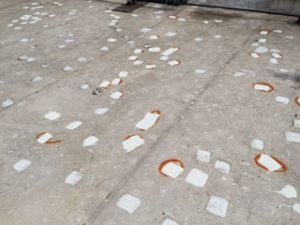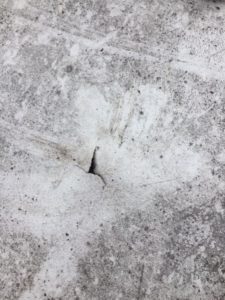When it comes to hail damage or another major weather event, the insurance industry might benefit from the “an ounce of prevention can equal a pound of cure” philosophy used in the healthcare world.
Let’s say a person has a simple respiratory infection. They can go to the doctor for a diagnosis and often times resolve the problem by just paying for an office visit and prescription. Then let’s consider the same respiratory infection being ignored until it gets to the point of pneumonia, requiring an emergency room visit and even possibly a stay in the hospital. Now the remedy is going to cost thousands of dollars.
The same principle applies in commercial roofing.

Let’s say there’s a hail issue or other type of climatic weather event. The best practice is to investigate and mitigate any issues promptly. If not, flash forward to the day a big, heavy rain hits that compromised roof, and the problems worsen; perhaps even to the point where the entire roof needs to be torn off and replaced as part of a massive claim.
Timely mitigation is the key to preventing the large claims brought on by roof replacements. Avoiding replacements means avoiding expensive claims. As long as water doesn’t enter the roof system to the point of getting moisture on the insulation, a replacement can potentially be avoided. There are other, much less expensive re-roof alternatives for mitigating hail and weather-related damage claims, and thankfully technology exists today to give us the information you need to make wise decisions.
Not all commercial roofing inspections are the same
Commercial roofers preach the importance of getting professional inspections biannually – ideally spring and fall – to monitor wear and tear against a baseline level for each roof’s condition. Even more prudently, inspections should also be done after major weather events like hail, high winds, heavy snowstorms and ice.
Building owners are the first line of responsibility, but a case can be made for insurers to initiate inspections as a preventative measure, as well, particularly for high-value properties in their portfolio. Insurance companies can not only be responsible for the wet insulation damage, but may also be responsible for all the damage inside the building, as well, to inventory, fixtures, equipment, files, etc.
Not everyone performs commercial roofing inspections with the same eye for detail. Ensure your assessment is a thorough, scientifically based, proper inspection consisting of:
- Core analysis testing – This not only tests the membrane to determine remaining useful life, it also reveals a look at all the components the roof is made up of, from the decking to the insulation to the membrane itself. It is important to determine the existing system’s condition and its current life expectancy in order to offer the best, most economical solution.
- Moisture survey of the roof system – Likely determined through infrared thermography, this is where you can determine how much water has embedded in the insulation, and if you can avoid a replacement and go with a less-costly and laborious fix, such as a repair or re-roof alternative.
- Visual inspection of membrane, flashings – An experienced roofing specialist can accurately identify – and even mitigate on the spot – certain types of damage that a general building maintenance technician or insurance adjuster might miss or have to schedule someone else to come address.
- Documentation of weather events – Weather events are documented and searchable through sophisticated software programs that note the severity and size of hail down to the minute and longitude/latitude location of a building. A proper inspection can include this to confirm if the suspected weather event actually occurred.
- Pre-negotiated pricing terms – Don’t wait until a weather event happens to initiate a relationship with a roofing specialist. Getting last minute pricing may push prices higher and likely cause a slower response time to your damage assessment.
When choosing someone to evaluate a commercial roof system, whether you’re the insurer or the insured, ask these questions to ensure you’re hiring a competent provider.
- Have they done weather-impact condition reports before?
- Are they using technology to standardize the process?
- Are they ISO-certified?
- Do they have moisture survey technology?
- Are they close enough to the site or are they going to charge higher than normal travel to get to the facility?
- Are they able to do the actual work when they’re there or will they have to schedule a separate person for that?
Hail damage doesn’t always equal roof replacement
Just because there was a hail event doesn’t mean the roof system is a complete failure and needs to be torn off and replaced. The type of roof system – a multi-ply, redundant system is durable against hail, for instance – as well as its age and condition determine how well it can withstand a hail event. The size of the hail and its duration in falling also play a role.
Youngstown, Ohio, NBC affiliate meteorologist Eric Wilhelm says hail diameter smaller than golf ball size is less likely to cause structural damage. But large hail compounded by high winds will lead to the most destruction.

“That’s the worst combination, and there was a dramatic example of that recently in Texas,” Wilhelm said. “In that instance you even saw windows on the sides of buildings damaged from golf ball and softball sized hail being blown sideways by the wind. Not only were there roof issues, but we also saw siding damage and general structural damage.”
Weather events with less than catastrophic damage to a roof, however, can in many cases be taken care of much less expensively if acted upon in a timely manner. An investment in timely inspection, testing and analysis to mitigate a small problem today will save countless dollars compared to letting the issue fester and create devastating damage later.
 Anthony Vross has 30-plus years of experience in all facets of the commercial roofing industry and is co-owner of Simon Roofing, a Youngstown, Ohio-based national installer/manufacturer/service provider of commercial roofing systems. Learn more at SimonRoofing.com
Anthony Vross has 30-plus years of experience in all facets of the commercial roofing industry and is co-owner of Simon Roofing, a Youngstown, Ohio-based national installer/manufacturer/service provider of commercial roofing systems. Learn more at SimonRoofing.com
Was this article valuable?
Here are more articles you may enjoy.

 CVS Accused of Illegal Opioid Dispensing in Whistleblower Suit
CVS Accused of Illegal Opioid Dispensing in Whistleblower Suit  New York Considers Making Property Insurers Cover Taxi Claims Losses
New York Considers Making Property Insurers Cover Taxi Claims Losses  Consulting Firm McKinsey to Pay $650M to Resolve Criminal Opioid Probe
Consulting Firm McKinsey to Pay $650M to Resolve Criminal Opioid Probe  Cargo Theft Surges as Holiday Season Approaches, Verisk Says
Cargo Theft Surges as Holiday Season Approaches, Verisk Says 